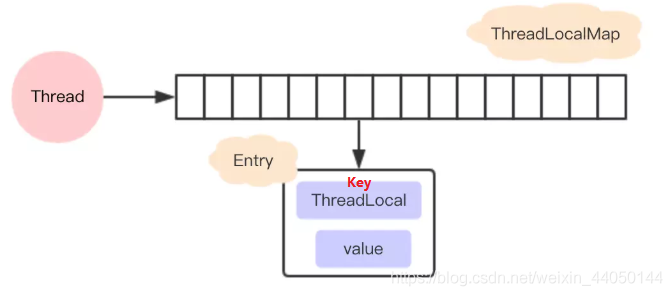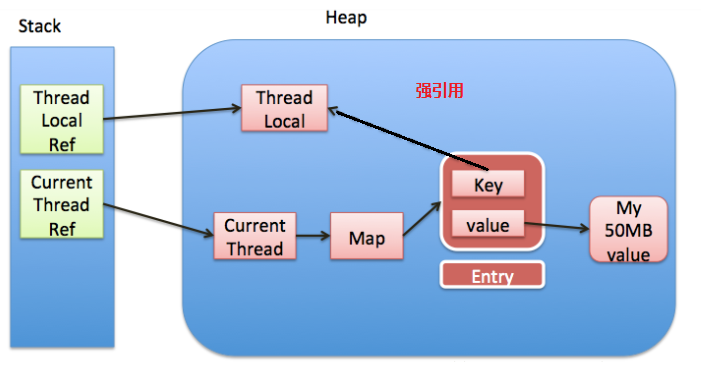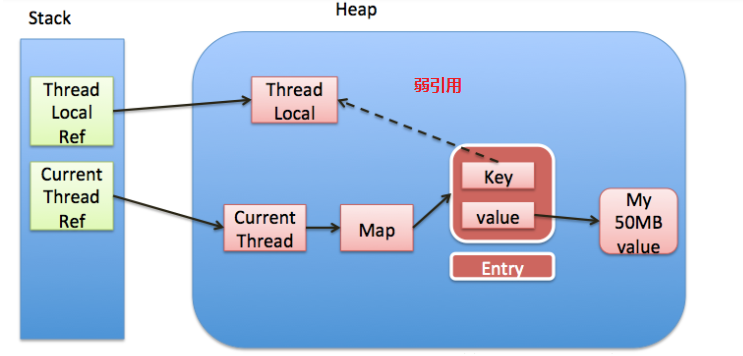ThreadLocal源码分析
最近在学多线程并发的知识,发现好像ThreadLoca还挺重要,决定看看源码以及查找各方资料来学习一下。
ThreadLocal能够提供线程的局部变量,让每个线程都可以通过set/get来对这个局部变量进行操作,不会和其它线程的局部变量进行冲突,实现了线程的数据隔离。
首先是ThreadLocal的结构:
每个Thread维护一个ThreadLocalMap,这个Map的的key就是ThreadLocal本身,value才是真正要存储的变量。所以这个变量当然是线程私有的。

相比于早期的结构,早期结构式Thread和ThreadLocal换了一下。好处就是:
1.当并发量够大时,如果时早期结构,那么意味着所有的线程都会去操作同一个map,map的体积可能会很大导致访问性能的下降。也就是说现在的设计会让每个map存储的entry数量变少,因为实际运用中,往往ThreadLocal的数量是少于Thread的数量。之前的存储数量是由Thread的数量决定,现在是由ThreadLocal的数量决定。
2.当Thread销毁之后,对应的ThreadLocalMap也会随之销毁,能够减少内存的使用。
接下来讲解一下ThreadLocal的核心方法
set方法:
public void set(T value) {
//获得当前线程 Thread t = Thread.currentThread(); ThreadLocalMap map = getMap(t);//得到实际存储的map if (map != null)如果map已经存在,那么就存入 map.set(this, value);//this就是当前ThreadLocal else createMap(t, value);//如果map不存在,那么创建map再set }
所以代码的执行流程就是:
首先获取当前线程,并根据当前线程获取一个Map,如果map存在,就直接set,如果不存在,就先创建map,再set。
get方法:
/**
返回当前线程中保存ThreadLocal的值,
如果当前线程没有此ThreadLocal变量,
则会通过调用setInitialValue方法进行初始化值。
*/
public T get() { Thread t = Thread.currentThread();//获得当前线程对象 ThreadLocalMap map = getMap(t);//获得当前map if (map != null) {如果map存在 ThreadLocalMap.Entry e = map.getEntry(this);//以当前的ThreadLocal为key,获得存储实体Entry类型的e if (e != null) {//如果e不为空 @SuppressWarnings("unchecked") T result = (T)e.value;//获得e中对应的value值。并返回 return result; } }
//会有两种情况执行当前代码
1.map不存在,
2.map存在,但是没有与当前ThreadLocal关联的entry。 return setInitialValue(); }
private T setInitialValue() { T value = initialValue();//调用initialValue获取初始化的值,此方法可以被子类重写,如果不重写默认返回null Thread t = Thread.currentThread();//获取当前线程对象 ThreadLocalMap map = getMap(t);//获得map if (map != null)如果map存在,那么直接set,则对应上面的第二种情况 map.set(this, value); else//对应上面的第一种情况 createMap(t, value);//那么对map初始化创建,将t(当前线程)和value作为第一个entry存放到map中。 return value; }
代码流程:首先获得当前线程,根据当前线程获取一个map。如果map不为空,则再map中以ThreadLocal的引用作为key来再map中获取对应的entry e。如果e不为null,则返回e.value,否则map为空或者e为空,则通过setInitialValue函数获取初始值value。然后用ThreadLocal的引用和value作为firstKey和firstValue创建一个新的map。
总结就是先获取当前线程的ThreadLocalMap变量,如果存在则返回值,不存在则创建并返回初始值。
remove方法:
删除当前线程中保存的ThreadLocal对应的实体entry
public void remove() {
//获取当前线程对象中维护的ThreadLocalMap对象 ThreadLocalMap m = getMap(Thread.currentThread()); if (m != null)//如果此map存在,则删除。 m.remove(this); }
private void remove(ThreadLocal<?> key) { Entry[] tab = table; int len = tab.length; int i = key.threadLocalHashCode & (len-1);//计算索引 for (Entry e = tab[i]; e != null; e = tab[i = nextIndex(i, len)]) {//进行线性探索,查找正确的key if (e.get() == key) { e.clear();//调用弱引用的claer()清除引用, expungeStaleEntry(i);//然后连续段清除。 return; } } }
接下来讲解ThreadLocalMap的源码
再上述的createMap方法中,
void createMap(Thread t, T firstValue) { t.threadLocals = new ThreadLocalMap(this, firstValue); }
ThreadLocalMap(ThreadLocal<?> firstKey, Object firstValue) { table = new Entry[INITIAL_CAPACITY]; int i = firstKey.threadLocalHashCode & (INITIAL_CAPACITY - 1); table[i] = new Entry(firstKey, firstValue); size = 1; setThreshold(INITIAL_CAPACITY); }
这里就采用了一个延迟初始化,在第一次调用get()或者set()方法的时候才会进行初始化。计算索引的时候是采用&长度-1,这其实就是%(2^n),也就是对2的幂进行取模,这也解释了为什么map长度一直为2的次方数。
ThreadLocalMap中的set()方法:
它使用线性探测法来解决哈希冲突,就是如果计算出下标是i,如果冲突了i=i+1,如果到了数组的最后一位,还是冲突,那么就从数组0位置再开始遍历。
private static int nextIndex(int i, int len) { return ((i + 1 < len) ? i + 1 : 0); } /** * Decrement i modulo len. */ private static int prevIndex(int i, int len) { return ((i - 1 >= 0) ? i - 1 : len - 1); }
private void set(ThreadLocal<?> key, Object value) { // We don't use a fast path as with get() because it is at // least as common to use set() to create new entries as // it is to replace existing ones, in which case, a fast // path would fail more often than not. Entry[] tab = table; int len = tab.length; int i = key.threadLocalHashCode & (len-1);//计算索引位置 for (Entry e = tab[i]; e != null; e = tab[i = nextIndex(i, len)]) {//根据获取到的索引进行循环,如果当前索引上的tab[i]不为空,在没有retuen的情况下,就使用nextIndex()获取下一个。也就是线性探测法 ThreadLocal<?> k = e.get();//这也就是tab[i]的key if (k == key) {判断是否与方法参数key相同,如果相同就替换value,然后return e.value = value; return; } if (k == null) {//key为null,但是值不为null,说明之前的ThreadLocal对象已经被回收了,那么当前数组中的Entry是一个陈旧的元素 replaceStaleEntry(key, value, i);//用新元素替换陈旧的元素,这个方法进行了不少的垃圾清理动作,防止内存泄露。 return; } } tab[i] = new Entry(key, value);//ThreadLocal对应的key不存在并且没有找到陈旧的元素,则在空元素的位置创建一个新的Entry。 int sz = ++size;
// cleanSomeSlots用于清除那些e.get()==null的元素,
// 这种数据key关联的对象已经被回收,所以这个Entry(table[index])可以被置null。
// 如果没有清除任何entry,并且当前使用量达到了负载因子所定义(长度的2/3),那么进行 if (!cleanSomeSlots(i, sz) && sz >= threshold) rehash(); }
总结:1.先通过key的hash值计算索引,然后根据获取到的索引i进行循环,循环结束的条件为tab[i]!=null。
1.1在循环里会进行判断,tab[i].get,就是table[i]的key,是否与方法参数key相同,相同就替换value,然后return
1.2如果不相同再判断entry的key是否为null,如果是null的话说明这个位置被回收了,那么调用replaceStaleEntry(key,value,i)方法,也就是替换无效的entry(那么再这个无效的table[i]处可以用新的key-value进行替换,并清楚其他无效的entry)。然后return。
2.如果循环结束了,说明当前table[i]为null,那就直接在这个位置放entry就ok了,然后size++;
3.最后进行判断,如果没有清楚任何一个entry并且当前size已经大于扩容因子了,也就是数组的2/3,那就需要rehash。
下面就讲解replaceStaleEntry(key, value, i);方法。
private void replaceStaleEntry(ThreadLocal<?> key, Object value, int staleSlot) { Entry[] tab = table;//entry数组 int len = tab.length; Entry e;//entry // Back up to check for prior stale entry in current run. // We clean out whole runs at a time to avoid continual // incremental rehashing due to garbage collector freeing // up refs in bunches (i.e., whenever the collector runs). int slotToExpunge = staleSlot;//之后用于清理的起点 for (int i = prevIndex(staleSlot, len);//这里是向staleSlot前扫描,时刻记住此时的staleSlot是一个无效的entry。 (e = tab[i]) != null; i = prevIndex(i, len)) if (e.get() == null)//向前扫描找到了第一个无效的entry。那么起点就是这个无效的entry,否则起点就是最开始的staleSlot slotToExpunge = i; // Find either the key or trailing null slot of run, whichever // occurs first for (int i = nextIndex(staleSlot, len);//接着向后扫描 (e = tab[i]) != null; i = nextIndex(i, len)) { ThreadLocal<?> k = e.get(); // If we find key, then we need to swap it // with the stale entry to maintain hash table order. // The newly stale slot, or any other stale slot // encountered above it, can then be sent to expungeStaleEntry // to remove or rehash all of the other entries in run. if (k == key) {//如果相等,那么更新value即可 e.value = value;这时候e就是一个有效的entry, tab[i] = tab[staleSlot];//然后这时候把无效的赋值到当前i位置 tab[staleSlot] = e;//再把这个entry赋值给最开始传入这个方法的位置处。也就是交换了位置。让无效的entry尽可能靠后。 // Start expunge at preceding stale entry if it exists if (slotToExpunge == staleSlot)//如果向前找没有找到无效的entry,那么开始的起点就是i。也就是交换后的无效的位置。 slotToExpunge = i; cleanSomeSlots(expungeStaleEntry(slotToExpunge), len); return; } // If we didn't find stale entry on backward scan, the // first stale entry seen while scanning for key is the // first still present in the run. if (k == null && slotToExpunge == staleSlot)//这里就是如果向前查找没有无效的entry,然后当前向后扫描的entry无效,则更新清理起点。 slotToExpunge = i; } // If key not found, put new entry in stale slot tab[staleSlot].value = null;//上面的k==key判断没有经历到的话,那么说明没有找到key,有也就是说key之前不存在,那么直接再最开始的无效entry,也就是tab[stableSlot]上新增即可 tab[staleSlot] = new Entry(key, value); // If there are any other stale entries in run, expunge them if (slotToExpunge != staleSlot)//经过上面的for循环之后到这,说明存在其他的无效entry需要进行清理。 cleanSomeSlots(expungeStaleEntry(slotToExpunge), len); }
总结一下:上面的目的就是两个,先把有效entry放在尽可能靠前的位置,然后从第一个无效entry的位置向后清理。
接下来就是expungeStaleEntry(slotToExpunge)方法:
private int expungeStaleEntry(int staleSlot) {//连续段清除 Entry[] tab = table; int len = tab.length; // expunge entry at staleSlot tab[staleSlot].value = null;//清理无效entry,置空 tab[staleSlot] = null; size--;//size减1,置空后table的被使用量减1 // Rehash until we encounter null Entry e; int i; for (i = nextIndex(staleSlot, len); (e = tab[i]) != null; i = nextIndex(i, len)) {//从staleSlot开始向后扫描一段连续的entry ThreadLocal<?> k = e.get(); if (k == null) {//如果遇到key为null,表示无效entry,进行清理 e.value = null; tab[i] = null; size--; } else {//如果key不为null,计算索引 int h = k.threadLocalHashCode & (len - 1); if (h != i) {计算出来的索引h与当前所在位置的索引i不一致,那么就置空当前的tab[i], tab[i] = null; // Unlike Knuth 6.4 Algorithm R, we must scan until // null because multiple entries could have been stale. while (tab[h] != null)//然后从h开始向后线性探测到第一个空的slot,把e赋值过去。 h = nextIndex(h, len); tab[h] = e; } } } return i;//下一个为空的slot索引。 }
总结:从第一个无效entry向后遍历连续entry,清理每一个无效entry,对有效的entry重新计算其数组位置,如果和当前位置不符就将其移动到重新计算的位置,如果存在冲突就采用线性探测,最后返回连续entry后的那个下标。这个下标对应的是tab[i]==null。
接下来就是cleanSomeSlots方法
//启发式的扫描清楚,扫描次数由传入的参数n决定。
//从i开始向后扫描,(不包括i,因为上面已经说了,i所对应的entry是null)
//n控制扫描次数,正常情况下为log2(n),如果找到了无效entry,会将n重置为table的长度len,然后再调用上面的方法进行连续段清除。
private boolean cleanSomeSlots(int i, int n) { boolean removed = false; Entry[] tab = table; int len = tab.length; do { i = nextIndex(i, len); Entry e = tab[i]; if (e != null && e.get() == null) { n = len;//这里就是找到了一个无效的entry,那么重置n,并段清除。 removed = true; i = expungeStaleEntry(i); } } while ( (n >>>= 1) != 0);//无符号的右移动,可以用于控制扫描次数在log2(n) return removed; }
接下来讲解rehash()方法:
private void rehash() { expungeStaleEntries();//全清理 // Use lower threshold for doubling to avoid hysteresis
//threshold = 2/3*len,所以-threshold / 4=len/2.这里主要是因为上面做了一次全清理所以减少,需要进行判断。判断的时候把阈值减少了。 if (size >= threshold - threshold / 4) resize(); }
private void expungeStaleEntries() { Entry[] tab = table; int len = tab.length; for (int j = 0; j < len; j++) { Entry e = tab[j]; if (e != null && e.get() == null) expungeStaleEntry(j); } }
private void resize() { Entry[] oldTab = table; int oldLen = oldTab.length; int newLen = oldLen * 2;//扩容,扩为原来的两倍,这样保证了长度为2的幂 Entry[] newTab = new Entry[newLen]; int count = 0; for (int j = 0; j < oldLen; ++j) { Entry e = oldTab[j]; if (e != null) { ThreadLocal<?> k = e.get(); if (k == null) { e.value = null; // Help the GC//虽然做过一次清理,但在扩容的时候可能会又存在key==null的情况 } else { int h = k.threadLocalHashCode & (newLen - 1);//同样用线性探测法来设置每个位置。 while (newTab[h] != null) h = nextIndex(h, newLen); newTab[h] = e; count++; } } } setThreshold(newLen);//设置新的阈值 size = count; table = newTab; }
接下来讲ThreadLocalMap中的getEntry()方法
private Entry getEntry(ThreadLocal<?> key) { int i = key.threadLocalHashCode & (table.length - 1);//根据key计算索引,获取entry Entry e = table[i]; if (e != null && e.get() == key)//如果这个table[i]不为null且其key等于key,就返回entry return e; else return getEntryAfterMiss(key, i, e);//如果不是,那就执行这个函数 }
private Entry getEntryAfterMiss(ThreadLocal<?> key, int i, Entry e) { Entry[] tab = table; int len = tab.length; while (e != null) { ThreadLocal<?> k = e.get(); if (k == key) return e; if (k == null) expungeStaleEntry(i);//清除无效的entry else i = nextIndex(i, len);//基于线性探测法向后扫描 e = tab[i]; } return null;//如果都没有就返回null }
最后就讲解一下内存泄露的问题
首先,内存泄漏跟entry中使用了弱引用没有关系。
先说内存泄漏的概念:内存泄漏值程序中已动态分配的堆内存由于某种原因程序未释放或者无法释放,造成系统内存的浪费,导致程序运行速度减慢什么系统崩溃等严重后果。
弱引用:垃圾回收器一旦发现了只有弱引用的对象,不管当前内存空间足够与否,都会回收它的内存。
强引用:平时的引用一般都是强引用,只要对象没有被置为null,在GC时就不会被回收。
如果key使用了强引用,那么会内存泄漏吗

那么当栈中的ThreadLocalref引用断开,那么在ThreadLocalref就被回收了。但是因为entry强引用了threadLocal,造成ThreadLocal无法被回收。在没有手动删除这个Entry以及CurrentThread依然运行的前提下,始终有强引用链 threadRef->currentThread->threadLocalMap->entry,Entry就不会被回收(Entry中包括了ThreadLocal实例和value),导致Entry内存泄漏。
也就是说,ThreadLocalMap中的key使用了强引用, 是无法完全避免内存泄漏的。
如果使用弱引用:

那么同样的代码中使用完了ThreadLocal,ThreadLocal Ref被回收了。
同时,由于entry指向的ThreadLocal是弱引用,所以ThreadLocal可以被顺利回收。也就是key为null。但是没有手动删除这个entry以及thread仍然运行的情况下,依然有ThreadRef-Thread-ThreadLocalMap-Entry value-Object这条引用存在。value不会被回收,那么就会导致内存泄漏。也就是说使用了弱引用。也有可能内存泄漏。
所以出现内存泄漏的真实原因:
1.没有手动删除这个Entry
2.CurrentThread依然运行。
第一点就是使用完ThreadLocal,调用其remove方法删除对应的Entry,就能避免内存泄漏
第二点就是ThreadLocalMap是Thread的一个树形,被当前线程所引用,所以它的生命周期跟Thread一样长,如果使用完ThreadLocal之后,如果当前Thread也随之执行结束,ThreadLocalMap自然也会被gc回收,从根源上避免内存泄漏。
那么为啥还要使用弱引用呢
刚刚直到要避免内存泄漏有两种方式
1.使用完ThreadLocal,调用其remove方法删除对应的Entry
2.使用完ThreadLocal,当前Thread也随之运行结束。
但是如果是线程池的话,那么线程结束时不会销毁的,只是返回线程池。
也就是说,只要记得在使用完ThreadLocal之后及时调用remove。无论key时强引用还是弱引用都不会有问题。那么使用key为弱引用的原因是为啥呢?
通过上述源码分析我们知道,在ThreadLocalMap中的set/get方法中,会对key为null进行判断。如果为null的话,那么是会对value置为null的。也就是清除。
这也就意味着使用完ThreadLocal,Thread依然运行的前提下,就算忘记调用remove方法,弱引用也会比强引用多一层保障:弱引用的ThreadLocal会被回收,对应的value在下一次ThreadLocalMap调用set,get,remove中的任一方法的时候都会清除,从而避免内存泄漏。



